经济学人双语版《无人驾驶汽车》.pdf
- 格式:pdf
- 大小:260.69 KB
- 文档页数:2
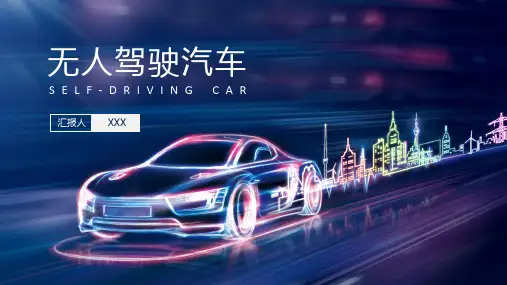

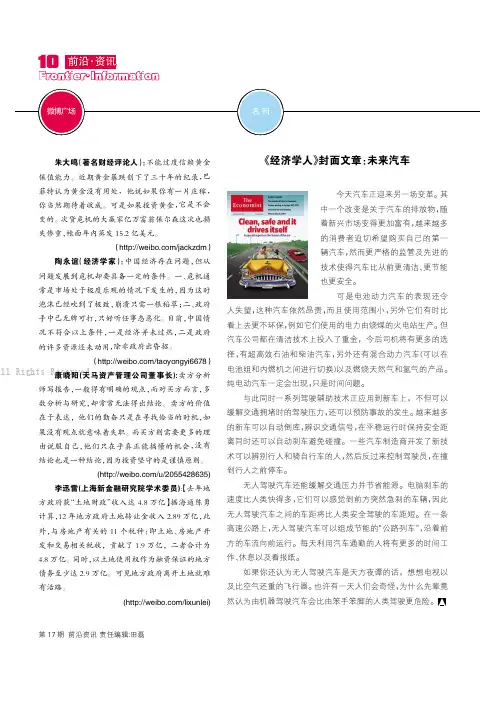
今天汽车正迎来另一场变革。
其中一个改变是关于汽车的排放物,随着新兴市场变得更加富有,越来越多的消费者迫切希望购买自己的第一辆汽车,然而更严格的监管及先进的技术使得汽车比从前更清洁、更节能也更安全。
可是电池动力汽车的表现还令人失望,这种汽车依然昂贵,而且使用范围小,另外它们有时比看上去更不环保,例如它们使用的电力由烧煤的火电站生产。
但汽车公司都在清洁技术上投入了重金,今后司机将有更多的选择,有超高效石油和柴油汽车,另外还有混合动力汽车(可以在电池组和内燃机之间进行切换)以及燃烧天然气和氢气的产品。
纯电动汽车一定会出现,只是时间问题。
与此同时一系列驾驶辅助技术正应用到新车上,不但可以缓解交通拥堵时的驾驶压力,还可以预防事故的发生。
越来越多的新车可以自动倒库,辨识交通信号,在平稳运行时保持安全距离同时还可以自动刹车避免碰撞。
一些汽车制造商开发了新技术可以辨别行人和骑自行车的人,然后反过来控制驾驶员,在撞到行人之前停车。
无人驾驶汽车还能缓解交通压力并节省能源。
电脑刹车的速度比人类快得多,它们可以感觉到前方突然急刹的车辆,因此无人驾驶汽车之间的车距将比人类安全驾驶的车距短。
在一条高速公路上,无人驾驶汽车可以组成节能的“公路列车”,沿着前方的车流向前运行。
每天利用汽车通勤的人将有更多的时间工作、休息以及看报纸。
如果你还认为无人驾驶汽车是天方夜谭的话,想想电视以及比空气还重的飞行器。
也许有一天人们会奇怪,为什么先辈竟然认为由机器驾驶汽车会比由笨手笨脚的人类驾驶更危险。
第17期前沿资讯责任编辑:田磊。
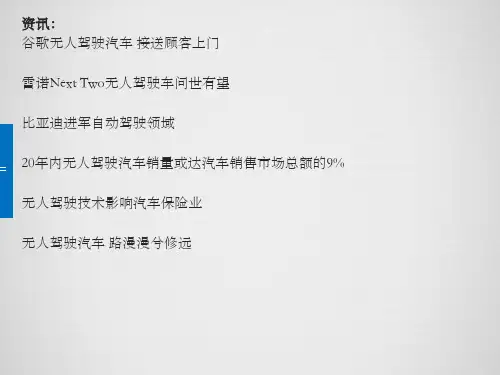
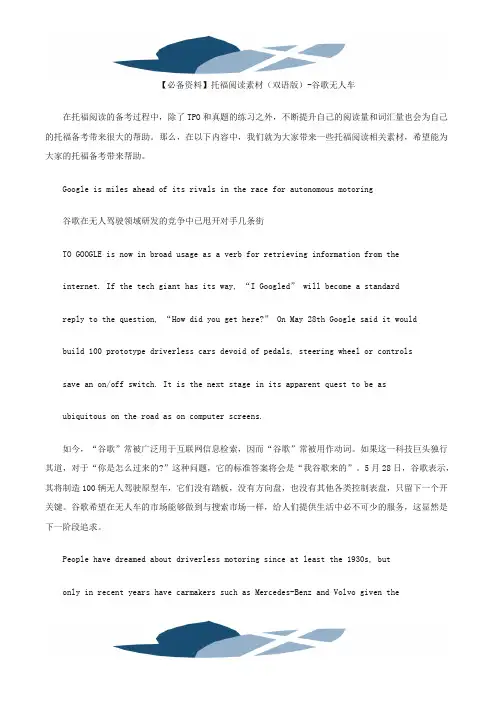
【必备资料】托福阅读素材(双语版)-谷歌无人车在托福阅读的备考过程中,除了TPO和真题的练习之外,不断提升自己的阅读量和词汇量也会为自己的托福备考带来很大的帮助。
那么,在以下内容中,我们就为大家带来一些托福阅读相关素材,希望能为大家的托福备考带来帮助。
Google is miles ahead of its rivals in the race for autonomous motoring谷歌在无人驾驶领域研发的竞争中已甩开对手几条街TO GOOGLE is now in broad usage as a verb for retrieving information from theinternet. If the tech giant has its way, “I Googled” will become a standardreply to the question, “How did you get here?” On May 28th Google said it wouldbuild 100 prototype driverless cars devoid of pedals, steering wheel or controlssave an on/off switch. It is the next stage in its apparent quest to be asubiquitous on the road as on computer screens.如今,“谷歌”常被广泛用于互联网信息检索,因而“谷歌”常被用作动词。
如果这一科技巨头独行其道,对于“你是怎么过来的?”这种问题,它的标准答案将会是“我谷歌来的”。
5月28日,谷歌表示,其将制造100辆无人驾驶原型车,它们没有踏板,没有方向盘,也没有其他各类控制表盘,只留下一个开关键。
谷歌希望在无人车的市场能够做到与搜索市场一样,给人们提供生活中必不可少的服务,这显然是下一阶段追求。
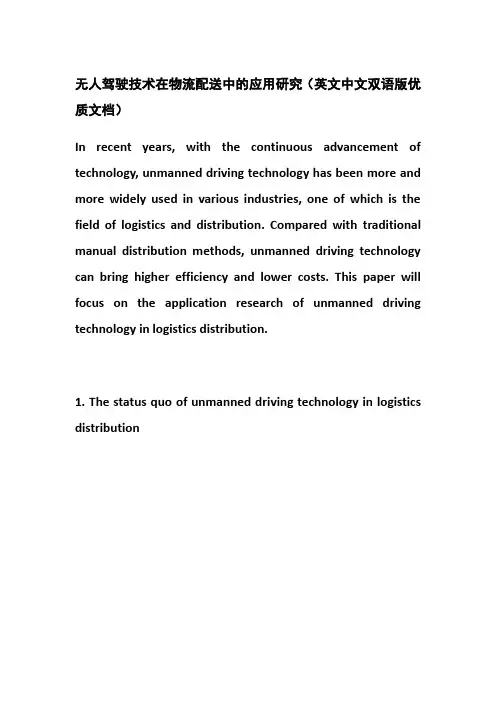
无人驾驶技术在物流配送中的应用研究(英文中文双语版优质文档)In recent years, with the continuous advancement of technology, unmanned driving technology has been more and more widely used in various industries, one of which is the field of logistics and distribution. Compared with traditional manual distribution methods, unmanned driving technology can bring higher efficiency and lower costs. This paper will focus on the application research of unmanned driving technology in logistics distribution.1. The status quo of unmanned driving technology in logistics distributionAt present, unmanned driving technology has been widely used in logistics and distribution. One of the most typical is the driverless delivery vehicle. Unmanned delivery vehicles use sensors such as lidar and cameras to perceive the environment. At the same time, they are equipped with high-precision maps and navigation systems, which can independently complete path planning and obstacle avoidance. In addition, unmanned delivery vehicles can also intelligently identify and classify items to achieve fast loading and unloading.2. Advantages of unmanned driving technology in logistics distribution1. Improve efficiencyCompared with the traditional manual delivery method, unmanned driving technology can realize 24-hour uninterrupted delivery service, avoiding the low delivery efficiency caused by manual fatigue, rest and other factors. Moreover, the driving speed of unmanned vehicles is more stable and will not be affected by human factors, so delivery tasks can be completed more quickly and efficiency can be improved.2. Reduce costsUnmanned vehicles can navigate and avoid obstacles autonomously without manual driving, thus saving labor costs. At the same time, unmanned vehicles can intelligently identify and classify items to achieve fast loading and unloading, so it can also save the cost of manual loading and unloading.3. Improve delivery securityUnmanned vehicles are equipped with a variety of sensors, which can sense the surrounding environment in real time and avoid traffic accidents. Moreover, unmanned vehicles can navigate and avoid obstacles autonomously, which can avoid accidents caused by human driving errors.3. Challenges of unmanned driving technology in logistics distribution1. Technical limitationsAt present, there are still some limitations in unmanned driving technology. For example, in complex weather conditions, the accuracy of sensors may be affected. At the same time, unmanned vehicles may experience uncertainty when facing complex road conditions, requiring more accurate algorithms and more advanced perception technologies to improve the vehicle's autonomous driving capabilities.2. Legal and regulatory restrictionsSince the application of unmanned driving technology in the field of logistics distribution is still in its infancy, relevant laws and regulations have not yet fully kept up. This has also led to the fact that in some areas, unmanned delivery vehicles cannot be officially put on the road, and relevant tests and verifications need to be carried out.3. User Acceptance IssuesCompared with traditional manual delivery methods, unmanned driving technology is still in a new and unfamiliar state. Therefore, some users may have some doubts and concerns about driverless delivery vehicles, such as vehicle safety and data privacy. This requires relevant companies to actively carry out publicity and education when promoting unmanned driving technology to increase user acceptance.4. Future OutlookWith the continuous development of unmanned driving technology, more innovations will be ushered in in the field of logistics and distribution. For example, unmanned delivery robots will be more widely used and can complete last-mile delivery services in urban centers. At the same time, the logistics distribution platform based on 5G and Internet of Things technology will also become more intelligent, enabling more efficient distribution services and more accurate cargo tracking.In general, the application of unmanned driving technology in the field of logistics and distribution has achieved certain results, but still faces some challenges and limitations. Only through continuous technological innovation and improvement of regulations can we better promote unmanned driving technology and allow it to play a greater role in the field of logistics and distribution.近年来,随着技术的不断进步,无人驾驶技术在各行各业中得到了越来越广泛的应用,其中之一就是物流配送领域。
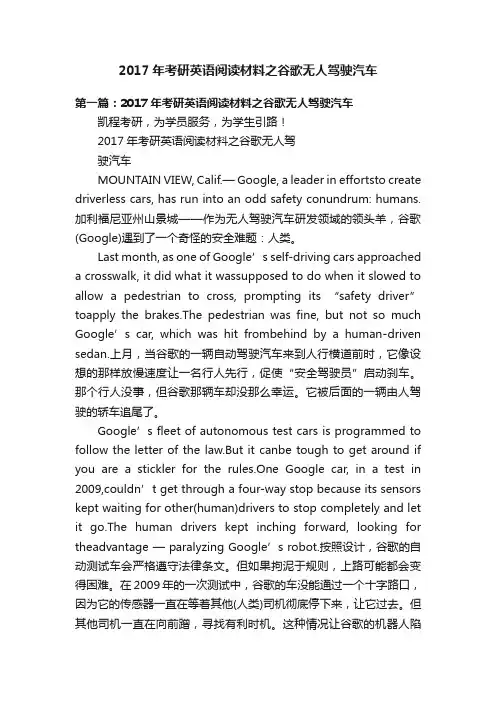
2017年考研英语阅读材料之谷歌无人驾驶汽车第一篇:2017年考研英语阅读材料之谷歌无人驾驶汽车凯程考研,为学员服务,为学生引路!2017年考研英语阅读材料之谷歌无人驾驶汽车MOUNTAIN VIEW, Calif.— Google, a leader in effortsto create driverless cars, has run into an odd safety conundrum: humans.加利福尼亚州山景城——作为无人驾驶汽车研发领域的领头羊,谷歌(Google)遇到了一个奇怪的安全难题:人类。
Last month, as one of Google’s self-driving cars approached a crosswalk, it did what it wassupposed to do when it slowed to allow a pedestrian to cross, prompting its “safety driver” toapply the brakes.The pedestrian was fine, but not so much Google’s car, which was hit frombehind by a human-driven sedan.上月,当谷歌的一辆自动驾驶汽车来到人行横道前时,它像设想的那样放慢速度让一名行人先行,促使“安全驾驶员”启动刹车。
那个行人没事,但谷歌那辆车却没那么幸运。
它被后面的一辆由人驾驶的轿车追尾了。
Google’s fleet of autonomo us test cars is programmed to follow the letter of the law.But it canbe tough to get around if you are a stickler for the rules.One Google car, in a test in 2009,couldn’t get through a four-way stop because its sensors kept waiting for other(human)drivers to stop completely and let it go.The human drivers kept inching forward, looking for theadvantage —paralyzing Google’s robot.按照设计,谷歌的自动测试车会严格遵守法律条文。
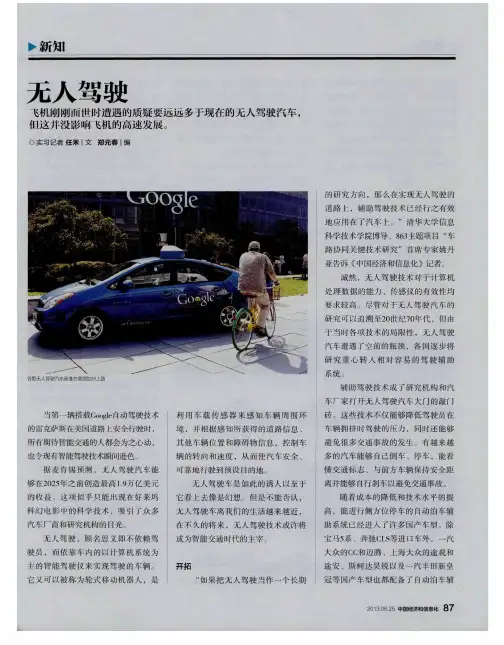
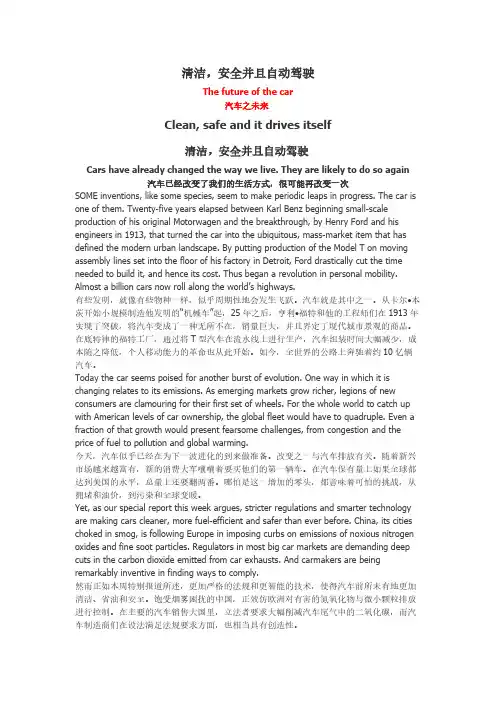
清洁,安全并且自动驾驶The future of the car汽车之未来Clean, safe and it drives itself清洁,安全并且自动驾驶Cars have already changed the way we live. They are likely to do so again 汽车已经改变了我们的生活方式,很可能再改变一次SOME inventions, like some species, seem to make periodic leaps in progress. The car is one of them. Twenty-five years elapsed between Karl Benz beginning small-scale production of his original Motorwagen and the breakthrough, by Henry Ford and his engineers in 1913, that turned the car into the ubiquitous, mass-market item that has defined the modern urban landscape. By putting production of the Model T on moving assembly lines set into the floor of his factory in Detroit, Ford drastically cut the time needed to build it, and hence its cost. Thus began a revolution in personal mobility. Almost a billion cars now roll along the world’s highways.有些发明,就像有些物种一样,似乎周期性地会发生飞跃。
经济学人双语版
Driverless cars 无人驾驶汽车(适合速读)
TO GOOGLE is now in broad usage as a verb for retrieving information from the internet. If the tech giant has its way, “I Googled” will become a standard reply to the question, “How did you get here?” On May 28th Google said it would build 100 p rototype driverless cars devoid of pedals, steering wheel or controls save an on/off switch. It is the next stage in its apparent quest to be as ubiquitous on the road as on computer screens.
如今,“谷歌”常被广泛用于互联网信息检索,因而“谷歌”常被用作动词。
如果这一科技巨头独行其道,对于“你是怎么过来的?”这种问题,它的标准答案将会是“我谷歌来的”。
5月28日,谷歌表示,其将制造100辆无人驾驶原型车,它们没有踏板,没有方向盘,也没有其他各类控制表盘,只留下一个开关键。
谷歌希望在无人车的市场能够做到与搜索市场一样,给人们提供生活中必不可少的服务,这显然是下一阶段追求。
People have dreamed about driverless motoring since at least the 1930s, but only in recent years have carmakers such as Mercedes-Benz and Volvo given the matter more thought, kitting out test cars with the sensors and sophisticated software required to negotiate busy roads. Google has roared ahead by designing a driverless car from the ground up.
至少从19世纪30年代起,人们就已经开始设想无人驾驶汽车,但只有一些汽车制造商,如奔驰、沃尔沃,在近些年尝试把这一想法付诸实践。
一辆装备着传感器和复杂软件的测试车需要在繁忙的道路上权衡最佳行车方案。
谷歌公司从零起步,设计无人驾驶汽车,已经鹤立鸡群。
But bringing autonomous motoring to the world is proving harder than Google had envisaged. It once promised it by 2017. Now it does not see production models coming out before 2020. The technology is far advanced, but needs shrinking in size and cost—Google's current test cars, retrofitted Toyota and Lexus models, are said to be packed with $80,000-worth of equipment.
但是现实证明,无人驾驶汽车的面世比谷歌预想的要难。
它曾承诺到2017年就能面世。
而今预计产品模型不会在2020年前被制造出来。
这项技术十分超前,但需要缩减产品尺寸及成本,谷歌现阶段的测试车改装自丰田和雷克萨斯的车型,据说测试车里塞满了价值8万美元的设备。
Google's latest efforts may have as much to do with convincing the public and lawmakers as refining the technology. The firm stresses the safety advantages of computers being more likely than humans to avoid accidents. The cars will have a top speed of just 25mph and a front end made of soft foam to cushion unwary pedestrians. The benefits could indeed be huge. Driving time could be given over to working, snoozing or browsing the web. Rather than suffer all the
costs of owning a car, some people may prefer to summon a rented one on their smartphones whenever they need it. However, the issue of liability in the event of a driverless car crashing has yet to be resolved.
谷歌最近不仅要努力的完善这项技术,还要同样努力的说服公众及立法者。
谷歌强调此产品的优势是安全性,在避免车祸方面,电脑比人类表现更佳。
无人驾驶汽车最高车速仅为25英里每小时,其前端由软泡沫材料制造而成,可缓冲粗心的行人。
这样确有很大好处。
开车的时间可以用于工作,打盹或上网冲浪。
比起自己承担拥有一辆车的开销,一些人可能更喜欢在需要车的时候,用他们的智能手机叫辆出租车。
然而,无人驾驶汽车发生车祸时的责任认定问题还有待解决。
Turning cars into commodities may not be good news for traditional carmakers. But reinventing motoring as a service fits neatly with Google's plans to become as big in hardware as in software. And unlike car firms, which talk vaguely of becoming “mobility providers”, Google has pots of cash to make that a reality and no worries about disrupting its current business. Google admits it still has “lots of work to do”. But one day Googling to the shops may be a common activity.
对传统汽车制造商来说,把无人驾驶汽车转化成为商品,也许不是什么好消息。
但是把汽车彻底转变成一种服务,正好契合了谷歌想在硬件领域发展的和在软件领域一样强大的计划。
普通汽车公司模糊的表达着成为“移动供应商”的想法,和这些汽车公司不同,谷歌拥有大量资金来实现无人驾驶的设想,并不担心这一项目会扰乱目前公司业务。
谷歌承认这一项目还有很多工作要做。
但是,有一天,乘坐谷歌无人驾驶汽车去商店购物,也许会变成寻常事。